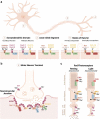Pleiotropic Ankyrins: Scaffolds for Ion Channels and Transporters
- PMID: 36082411
- PMCID: PMC9467607
- DOI: 10.1080/19336950.2022.2120467
Pleiotropic Ankyrins: Scaffolds for Ion Channels and Transporters
Abstract
The ankyrin proteins (Ankyrin-R, Ankyrin-B, and Ankyrin-G) are a family of scaffolding, or membrane adaptor proteins necessary for the regulation and targeting of several types of ion channels and membrane transporters throughout the body. These include voltage-gated sodium, potassium, and calcium channels in the nervous system, heart, lungs, and muscle. At these sites, ankyrins recruit ion channels, and other membrane proteins, to specific subcellular domains, which are then stabilized through ankyrin's interaction with the submembranous spectrin-based cytoskeleton. Several recent studies have expanded our understanding of both ankyrin expression and their ion channel binding partners. This review provides an updated overview of ankyrin proteins and their known channel and transporter interactions. We further discuss several potential avenues of future research that would expand our understanding of these important organizational proteins.
Keywords: Ankyrin; Ankyrin-B; Ankyrin-G; Ankyrin-R; calcium channels; exchange proteins; ion channels; potassium channels; pumps; scaffold; sodium channels; transporters.
Conflict of interest statement
No potential conflict of interest was reported by the authors.
Figures


Similar articles
-
Spectrin- and ankyrin-based membrane domains and the evolution of vertebrates.Curr Top Membr. 2013;72:1-37. doi: 10.1016/B978-0-12-417027-8.00001-5. Curr Top Membr. 2013. PMID: 24210426
-
Structure of the ZU5-ZU5-UPA-DD tandem of ankyrin-B reveals interaction surfaces necessary for ankyrin function.Proc Natl Acad Sci U S A. 2012 Mar 27;109(13):4822-7. doi: 10.1073/pnas.1200613109. Epub 2012 Mar 12. Proc Natl Acad Sci U S A. 2012. PMID: 22411828 Free PMC article.
-
An Adaptable Spectrin/Ankyrin-Based Mechanism for Long-Range Organization of Plasma Membranes in Vertebrate Tissues.Curr Top Membr. 2016;77:143-84. doi: 10.1016/bs.ctm.2015.10.001. Epub 2015 Nov 30. Curr Top Membr. 2016. PMID: 26781832 Review.
-
Ankyrin-G coordinates assembly of the spectrin-based membrane skeleton, voltage-gated sodium channels, and L1 CAMs at Purkinje neuron initial segments.J Cell Biol. 2001 Nov 26;155(5):739-46. doi: 10.1083/jcb.200109026. Epub 2001 Nov 26. J Cell Biol. 2001. PMID: 11724816 Free PMC article.
-
Spectrin and ankyrin-based cytoskeletons at polarized domains in myelinated axons.Exp Biol Med (Maywood). 2008 Apr;233(4):394-400. doi: 10.3181/0709-MR-243. Exp Biol Med (Maywood). 2008. PMID: 18367627 Review.
Cited by
-
Age-dependent regulation of axoglial interactions and behavior by oligodendrocyte AnkyrinG.bioRxiv [Preprint]. 2024 Apr 2:2024.04.01.587609. doi: 10.1101/2024.04.01.587609. bioRxiv. 2024. PMID: 38617359 Free PMC article. Preprint.
-
Ion channel trafficking implications in heart failure.Front Cardiovasc Med. 2024 Feb 14;11:1351496. doi: 10.3389/fcvm.2024.1351496. eCollection 2024. Front Cardiovasc Med. 2024. PMID: 38420267 Free PMC article. Review.
-
The T-type calcium channelosome.Pflugers Arch. 2024 Feb;476(2):163-177. doi: 10.1007/s00424-023-02891-z. Epub 2023 Dec 1. Pflugers Arch. 2024. PMID: 38036777 Review.
-
Spatial positioning of preimplantation mouse embryo cells is regulated by mTORC1 and m7G-cap-dependent translation at the 8- to 16-cell transition.Open Biol. 2023 Aug;13(8):230081. doi: 10.1098/rsob.230081. Epub 2023 Aug 9. Open Biol. 2023. PMID: 37553074 Free PMC article.
-
Multiprotein Assemblies, Phosphorylation and Dephosphorylation in Neuronal Cytoskeleton.bioRxiv [Preprint]. 2023 Jun 22:2023.06.21.545989. doi: 10.1101/2023.06.21.545989. bioRxiv. 2023. PMID: 37502949 Free PMC article. Preprint.
References
-
- Bennett V, Lorenzo DN.. An adaptable spectrin/ankyrin-based mechanism for long-range organization of plasma membranes in vertebrate tissues. Curr Top Membr. 2016;77:143–184. - PubMed
-
- Bennett V, Healy J. Organizing the fluid membrane bilayer: diseases linked to spectrin and ankyrin. Trends Mol Med. 2008;14(1):28–36. - PubMed
Publication types
MeSH terms
Substances
Grants and funding
LinkOut - more resources
Full Text Sources

